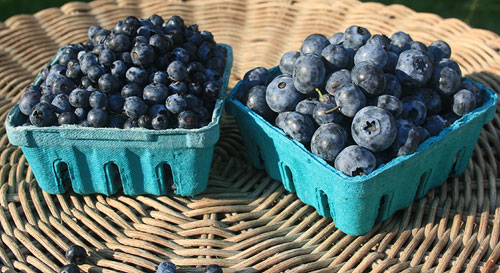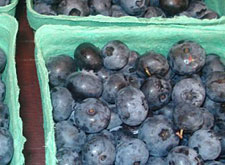What Is the Color of a Blueberry
 Blueberries
Blueberries© Denzil Green
- 1 Cooking Tips
- 2 Substitutes
- 3 Nutrition
- 4 Equivalents
- 4.1 Drying equivalents
- 4.2 Yields
- 4.3 Equivalents
- 5 Storage Hints
- 6 History Notes
- 7 Literature & Lore
- 8 Language Notes
The berries grow on new wood. They must be ripe when picked, as they won't ripen any further after that. Most harvesting is still done manually, with a special rake. Mechanization is being tried, but is difficult owing to the rougher terrain the blueberries favour growing on. Cultivated blueberries are twice the size of wild blueberries, but the wild berries have a more concentrated flavour. Still, they can be used interchangeably.
Most fresh blueberries for sale are cultivated ones; 99% of the wild crop is sold frozen.
Blueberries don't crush quite as easily as other soft summer berries, because their skin is a tad thicker. But even so, crush they will if mishandled.
When buying fresh blueberries, select ones that are completely blue with no red tinge left (the red tinge means they are underripe.) Look at the bottom of container they have come in: if it is clear, look for crushed ones (avoid that container); if a cardboard container, look for juice stains (which means there are crushed berries at the bottom.)
Cooking Tips
Wash before using. Discard any mouldy ones. Remove any stems and discard. Use frozen berries straight from the freezer; don't thaw first. Add frozen berries to batter at the last minute, just before turning into pan for baking.
Don't use blueberries in recipes where you have used baking soda, as they will react with the baking soda and turn green.
Substitutes
Many everyday recipes will call for a can of blueberries. If you only have fresh, and want to follow the recipe exactly, you can make your own "can". Cook the following in a saucepan until thickened and clear (cool before using):
2-1/2 cups of fresh blueberries
1 tablespoon of corn starch
1-1/2 teaspoons of lemon juice
1/8 cup of water
Nutrition
Good source of Vitamin C. High in folic acid.
Equivalents
[Note: volume equivalents will vary based on size of the berries, which can vary by variety and growing conditions.]
- 1 dry pint of fresh blueberries = 10 to 12 to 14 oz = 2 cups
- 1 pound (450 g) fresh or frozen = 3 1/2 cups
- 1 cup fresh blueberries = 9 oz = 250 g
- 21 oz (620 ml) can blueberry pie filling = 2 1/3 cups
- 10 oz (285 g) frozen Blueberries equals 1 1/2 cups
- 1 cup canned, drained = 9 oz = 250 g
- 1 litre (US quart) whole, fresh blueberries = 750 g (1 1/2 lbs), whole fresh
- 4 litres (US quarts) fresh blueberries = 3 litres (US quarts), blanched for 30 seconds
- 500 g / 1 lb blueberries = 2 2/3 cups, whole = 425 ml (1 3/4 cups) crushed [1] Ball / Bernardin Complete Book, 2015, page 427.
Drying equivalents
The following information is reproduced from our sister site, Health Canning. See that site for full directions on drying blueberries.
Blueberries come in vastly different sizes. The size worked with was medium (1.5 cm / two-thirds of an inch wide); your mileage may vary.
Yields
- Per 1 kg (2.2 lbs / 1 1/2 quarts / 1 1/2 litres) of fresh blueberries that you intend to dry, you will need 1 1/2 Excalibur square 15″ x 15″ dehydrator trays
- A 9 tray square Excalibur with 15″ x 15″ dehydrator trays can process 5.5 kg (12 1/2 lbs) of fresh blueberries at one time (depending on diligent you are at spacing the berries out properly).
- 5.5 kg (12.5 lbs / 8 quarts volume / 8 litres volume) fresh blueberries = 1 kg (2.2 lbs / 3 quarts in volume / 1 litre in volume) dried
- If the resulting 1 kg (2.2 lbs) of dried blueberries are stored all in one jar, you would need a jar 3 litres / quarts in capacity.
Equivalents
- 1 kg fresh blueberries, avg 1.5 cm diameter, = 1.5 litres in volume
- 3 lbs fresh blueberries, avg 1.5 cm diameter, = 2 quarts in volume
- 5.5 kg fresh blueberries (12.5 lbs), avg 1.5 cm diameter, = 8 quarts or litres in volume
- 1 kg fresh blue berries, avg 1.5 cm diameter, = 1.5 litres fresh blueberries in volume = 1 kg / 1 litre blanched and drained blueberries
Storage Hints

Comparing "wild" lowbush berries (L) to cultivated bush blueberries (R)
© Denzil Green
Store in a sealed container in refrigerator for up to two weeks after being picked (or about 1 week after bringing home from the store.) Don't wash before refrigerating, as water on them will hasten mould and deterioration. During storage in refrigerator, look them over occasionally and discard any mouldy or crushed ones.
To freeze, wash them first, but dry them off before freezing. Pack them then just as they are, with no added sugar, in bags or containers, seal and freeze for up to 9 months to a year. (Alternatively, instead of waiting for them to dry after washing, you can spread them out on a cookie sheet in the freezer, let freeze, and then pack for freezing.) The berries will freeze nicely without clumping together and will pour out of the containers like small balls. To use them in your baking, use them straight from the freezer. Don't let them thaw as they will then moosh and bleed into your baked goods.
To dry blueberries out completely, wash, they spread out in a single layer on a cookie sheet and let stand somewhere sunny (and preferably bug free) for up to 5 days. Store them indefinitely in a sealed glass jar away from light.
History Notes

Blueberries
© Paula Trites
Blueberries are native to North America, though closely related species are found in Europe ("Bilberries") and in Japan ("Bog Blueberries".)
Indians in North America introduced the colonists to blueberries. The Indians had called them "star berries", because blueberries have a little five-pointed star at the bottom. They sold them, dried in the sun, to the colonists, who would use them in place of raisins and currants.
The colonists thought at first that they were a form of bilberry, which grows in the UK.
Ninety to ninety-five per cent of the world's blueberries are still produced in North America.
Blueberries were always picked from the wild, until work began on developing improved, cultivated varieties around 1900. Cultivated varieties were first sent to England in 1946, arriving in Dorset, which has since become a centre of production.
Literature & Lore
"You ought to have seen what I saw on my way
To the village, through Mortensons' pasture today:
Blueberries as big as the end of your thumb,
Real sky-blue, and heavy, and ready to drum
In the cavernous pail of the first one to come!
And all ripe together, not some of them green
And some of them ripe! You ought to have seen!"
— Robert Frost (1874 – 1963). From the poem "Blueberries", in the collection called "North of Boston", published 1914.
Tonight I am content. Nothing more than an empty house, the warm, hazy weariness from a day spent setting strawberry runners in the sun, a glass of cool, sweet milk, and a dish of blueberries bathed in cream." — Sylvia Plath, American Poet, 1950.
"If you do wash blueberries before freezing, dry blueberries completely after rinsing, or else the moisture on the blueberry skin will cause tougher skins." (Andress, Elizabeth. It's Berry Season. National Center for Home Food Preservation. Blog post 16 June 2016. Accessed June 2016 at .https://preservingfoodathome.com/2016/06/15/its-berry-season/ [/ref]
Language Notes
There are three main varieties of Blueberries:
- Vaccinium corymbosum, a cultivated variety;
- Vaccinium angustifolium, a semi-wild one;
- Vaccinium Myrtillus (Bilberry), mainly found in Europe.
The cultivated variety (Vaccinium corymbosum) is larger and sweeter than the other two.
Other names
AKA: Blaeberries, Bluettes, Hurtleberries, Myrtilles
Scientific Name: Vaccinium angustifolium, Vaccinium corymbosum, Vaccinium Myrtillus
Italian: Mirtilli
French: Bluets, Myrtilles
German: Heidelbeeren
Dutch: Blauwbes, Bosbes
Spanish: Arándanos
Portuguese: Airelas, Vacínios
This page first published: · Updated: .
This web site generates income from affiliated links and ads at no cost to you to fund continued research · Information on this site is Copyright © 2021· Feel free to cite correctly, but copying whole pages for your website is content theft and will be DCMA'd.
What Is the Color of a Blueberry
Source: https://www.cooksinfo.com/blueberries